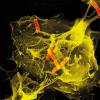Deputy Editor Ian Paterson, from the Department of Oral and Craniofacial Sciences at the University of Malaya, summarises the articles recently published in the British Journal of Biomedical Science.

Two articles published in April were submitted as part of the Journal’s special issue “Education and Training in Biomedical Science”. The first was a review by Pearse and Scott, which discussed the historical challenges in clinical laboratory education, training and progression and how these were impacted by COVID-19. Prior to the pandemic, the clinical laboratory workforce was already undergoing a transformation following the Carter reports and the Modernising Scientific Careers initiative. The creation of pathology networks, with an emphasis on standardisation, digitisation and IT connectivity, required laboratory professionals to be flexible and willing to undertake relevant lifelong learning to react to changing demands. With the background of such challenges, the pandemic hit and had a huge impact on teaching and learning, including online assessments and the acquisition of practical skills for trainees in a virtual environment. A discussion of the impact on clinical services and the mental health of the workforce is beyond the scope of this summary, but is reviewed in detail by the authors. The review identifies the need for more research into the impact of pre- and post-COVID challenges on the workforce. Despite these challenges, long-standing issues, such as staffing, resources and the mental health of staff, are now receiving attention. It is hoped that the IBMS Corporate Strategy 2022 and the 2023 revised Quality Assurance Agency (QAA) benchmark statement for biomedical sciences will be reflected in higher education courses, ensuring a sustainable, competent, flexible and diverse workforce that is rightly appreciated, respected and rewarded.
The ability to effectively communicate research findings to the scientific community and the public is a vital transferable skill that needs to be developed in both undergraduate and postgraduate settings. Both the IBMS and QAA require the development of such transferable skills in accredited programmes. The COVID-19 pandemic clearly highlighted the need to communicate complex biology effectively and clearly to the general public. Continuing with the general theme of training and curriculum development, Millar et al. report on an action research project designed to create an online resource, or “toolkit” to develop communication and digital literacy for undergraduate biomedical science students at Ulster University. A mixed methods approach was used involving final-year students undertaking a research project and staff and included questionnaires, focus groups and surveys to develop the resource. An online scientific communication and digital capabilities toolkit was prepared to support students in preparing three outputs – a visual abstract, lay summary and written reflection focusing on educational experiences within the module and employability. Feedback from students and staff was positive and students recognised the importance of such transferable skills for employment.
Reference intervals for parathyroid hormone using Abbott methods
Parathyroid hormone (PTH) is secreted by the parathyroid glands and hyperparathyroidism is the term used for a group of disorders that result from excess PTH secretion. It can be primary as a consequence of autonomous secretion in one of the four glands, or secondary due to low calcium and/or low vitamin D. An accurate measurement of PTH is essential for the identification of patients with hyperparathyroidism and also upon an accepted range of PTH concentrations in healthy individuals – the reference interval (RI). Mirzazadeh and colleagues examined “local” RIs from four different sites across the UK – Oxford, Birmingham, Buckinghamshire and Epsom St Helier NHS trusts. All sites used the i2000 Abbott Architect intact PTH assay as recommended by the manufacturer. The study collected data from 1727 adults to calculate plasma PTH reference intervals. The manufacturer’s recommended normal range for plasma PTH was 1.6–7.2 pmol/L. Although the manufacturer states that data from different labs may vary and local ranges should be determined, the reference range of 1.6–7.2 pmol/L is widely used in clinical practice. The results showed that all four sites had different upper limits and the site-specific upper limits were all higher than those quoted by the manufacturer. The combined RIs from the four sites was approximately 3–14 pmol/L. Interestingly, these limits were similar to those found in a recent report by Minieri et al. (2021) in Italian patients. The four sites involved have now adopted their own locally derived RIs and the data provide strong evidence that locally derived plasma PTH RIs are required for the adult UK population to prevent misdiagnosis and inappropriate patient follow-up.

Hospital-acquired infections represent a major clinical problem
Hospital reservoirs of multidrug-resistant Acinetobacter species
Hospital-acquired infections (HAIs) represent a major clinical problem. It is estimated that environmental contamination contributes up to 20% of all such infections and there is strong evidence to show this contributes significantly to the spread of pathogens, including multidrug-resistant organisms (MDROs). In this review, Fahy et al. focus on one opportunistic pathogen, Acinetobacter baumannii, to highlight some of the problems associated with environmental contamination and to suggest ways to reduce the impact of such HAIs in the future. A. baumannii are Gram-negative coccobacilli that are most often associated with aquatic environments that are thought to be responsible for approximately 2%–10% of all Gram-negative HAIs. A. baumannii is a particular problem because it is an opportunistic pathogen, a biofilm former and an environmental reservoir of mobile genetic elements that can potentially be transferred to other pathogens. One gene, ompA, encodes OmpA, a key stress and virulence factor that leads to apoptotic cell death. OmpA is also responsible for the formation of biofilms on surfaces, which increase bacterial survival in hospital environments. A. baumannii has also been shown to be extremely antibiotic resistant, with resistance to third-generation cephalosporins and carbapenems being reported several decades ago. The authors conclude that current screening for environmental contamination with MDROs in clinical settings is inadequate and needs to improve to extend the usefulness of current antibiotics. It is suggested that A. baumannii could be a useful marker organism in microbiological screening protocols for the presence of other pathogens.
Faecalibacterium prausnitzii as a potential therapy for type 2 diabetes
The microorganisms that grow in the intestinal tract, the gut microbiome, are now recognised as playing a major role in health and disease. One such organism, Faecalibacterium prausnitzii, has been shown to secrete anti-inflammatory compounds and a decreased abundance of F. prausnitzii has been found to be associated with a number of human diseases, including diabetes, suggesting that F. prausnitzii has some anti-diabetic properties. The study by Xuan et al. initially used qPCR to show that the abundance of F. prausnitzii was significantly lower in the faeces of patients with type 2 diabetes compared with healthy control subjects. They went on to use a mouse model of type 2 diabetes to examine the specific role F. prausnitzii in the disease. They used leptin receptor-deficient mice that developed a phenotype that is similar to type 2 diabetes with symptoms including insulin resistance, obesity, hyperphagia, hyperinsulinaemia and non-alcoholic fatty liver disease. The results showed that dietary supplementation with F. prausnitzii resulted in decreased fasting blood glucose and insulin resistance. F. prausnitzii also improved inflammation in both adipose tissue and liver, and ameliorate hepatic steatosis through inhibiting the activity of hepatic lipogenic enzymes. Taken together, these results suggest that F. prausnitzii might be a therapeutic option for patients with type 2 diabetes.
Elevated expression of miR-296 as a potential marker for pre-eclampsia
Pre-eclampsia (PE) is a condition that affects some pregnant women and affected women present with hypertension and proteinuria. There is a risk of serious complications for both mother and baby. However, the exact causes of PE are not well understood but it is thought to be due to problems with blood supply to the placenta. It would be beneficial to be able to identify those individuals who are at greater risk of developing PE. MicroRNAs are small, highly conserved non-coding RNA molecules involved in the regulation of gene expression. It was reported by Choi et al. in 2013 that a microRNA, miR-296, was elevated in patients with PE but the possible clinical utility of this observation has not been examined. The report by Zhu et al. shows that miR-296 expression was significantly increased in serum samples from both early and late onset PE compared with women with healthy pregnancies. The levels of miR-296 decreased after delivery. ROC curves were constructed and miR-296 levels could differentiate early and late PE patients from healthy control mothers. Interestingly, miR-296 is thought to play a role in angiogenesis. The authors suggest that miR-296 is a potential biomarker for the diagnosis and predicting the developing of PE.

miR-296 is a potential biomarker for predicting the developing of pre-eclampsia
CCAT1 – a potential biomarker in colorectal cancer
Colorectal cancer (CRC) is the third most common cancer and second deadliest cancer in both men and women in the world. The five-year survival of patients with CRC remains relatively low, particularly for those patients diagnosed with stage III and IV disease. Long non-coding (lnc) RNAs are non-coding RNAs longer than 200 nucleotides. lncRNAs primarily interact with mRNA, DNA, protein, and miRNA and consequently regulate gene expression at multiple levels to regulate many biological processes. Deregulated expression of many lncRNAs has been reported in carcinogenesis, including colon cancers. lncRNA colon cancer-associated transcript 1 (CCAT 1) is an oncogenic lncRNA that is overexpressed in CRC and is associated with tumorigenesis and resistance to chemotherapy. Liau et al. have reviewed the role of CCAT 1 in colon cancer and summarised its function in CRC carcinogenesis. CCAT 1 is produced as two isoforms – a short transcript, CCAT1-S, which resides in the cytoplasm, and a longer form, CCAT1-L, which remains in the nucleus. Both isoforms have been detected in CRC tissues. CCAT 1 is associated with advanced features of CRC, such as lymph node and distant metastasis, and functions to promote tumour cell proliferation, migration and invasion. It is associated with the inhibition of apoptosis and chemoresistance. Mechanistically, CCAT 1 positively regulates the transcription of the c-MYC oncogene and acts as a molecular sponge to bind and inhibit a number of miRNAs. Collectively, this information suggests that CCAT 1 is a potential biomarker for screening and prognostication, as well as being a possible future therapeutic target.
Image Credit | SCIENCE-PHOTOLIBRARY | Shutterstock | Promega




